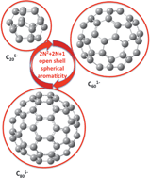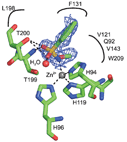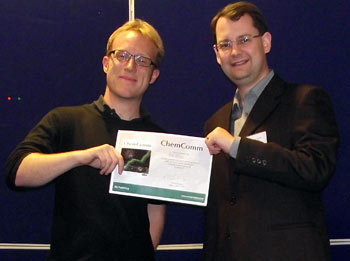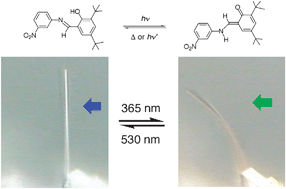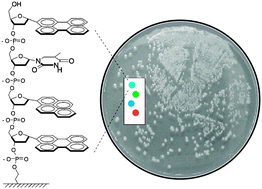This month sees the following articles in ChemComm that are in the top ten most accessed:-
A molecular probe for the optical detection of biogenic amines
Boram Lee, Rosario Scopelliti and Kay Severin
Chem. Commun., 2011, 47, 9639-9641, DOI: 10.1039/C1CC13604F
Photocatalytic hydrogen production
Thomas S. Teets and Daniel G. Nocera
Chem. Commun., 2011, 47, 9268-9274, DOI: 10.1039/C1CC12390D
A near-infrared fluorescent calcium probe: a new tool for intracellular multicolour Ca2+ imaging
Akihiro Matsui, Keitaro Umezawa, Yutaka Shindo, Tomohiko Fujii, Daniel Citterio, Kotaro Oka and Koji Suzuki
Chem. Commun., 2011, 47, 10407-10409, DOI: 10.1039/C1CC14045K
Neocuproine–KO t Bu promoted intramolecular cross coupling to approach fused rings
Chang-Liang Sun, Yi-Fan Gu, Wei-Ping Huang and Zhang-Jie Shi
Chem. Commun., 2011, 47, 9813-9815, DOI: 10.1039/C1CC13907J
Supramolecular polymer for explosives sensing: role of H-bonding in enhancement of sensitivity in the solid state
Bappaditya Gole, Sankarasekaran Shanmugaraju, Arun Kumar Bar and Partha Sarathi Mukherjee
Chem. Commun., 2011, 47, 10046-10048, DOI: 10.1039/C1CC13925H
Incorporation of chemical functionalities in the framework of mesoporous
silica Noemi Linares, Elena Serrano, Marisa Rico, Alina Mariana Balu, Elia Losada, Rafael Luque and Javier García-Martínez
Chem. Commun., 2011, 47, 9024-9035, DOI: 10.1039/C1CC11016K
Highly sensitive and selective colorimetric visualization of streptomycin in raw milk using Au nanoparticles supramolecular assembly
Jiayu Sun, Jiechao Ge, Weimin Liu, Zhiyuan Fan, Hongyan Zhang and Pengfei Wang
Chem. Commun., 2011, 47, 9888-9890, DOI: 10.1039/C1CC12910D
A fluorescent turn-on probe for the detection of alkaline phosphatase activity in living cells
Tae-Il Kim, Hyunjin Kim, Yongdoo Choi and Youngmi Kim
Chem. Commun., 2011, 47, 9825-9827, DOI: 10.1039/C1CC13819G
Fluorescent nanoparticles based on a microporous organic polymer network: fabrication and efficient energy transfer to surface-bound dyes
Abhijit Patra, Jan-Moritz Koenen and Ullrich Scherf
Chem. Commun., 2011, 47, 9612-9614, DOI: 10.1039/C1CC13420E
Yolk/shell nanoparticles: new platforms for nanoreactors, drug delivery and lithium-ion batteries
Jian Liu, Shi Zhang Qiao, Jun Song Chen, Xiong Wen (David) Lou, Xianran Xing and Gao Qing (Max) Lu
Chem. Commun., 2011, Advance Article, DOI: 10.1039/C1CC13658E
Why not take a look at the articles today and blog your thoughts and comments below.
Fancy submitting an article to ChemComm? Then why not submit to us today or alternatively contact us with your suggestions.
